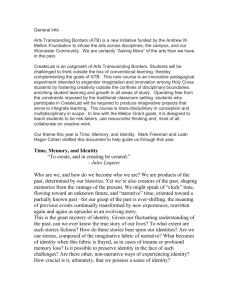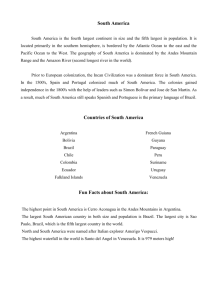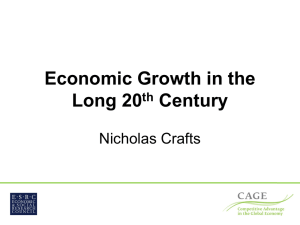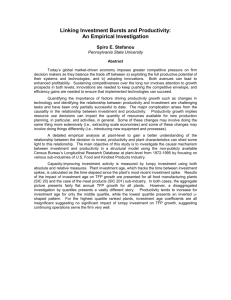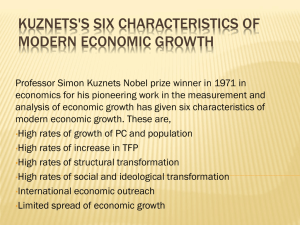Diapositiva 1
advertisement
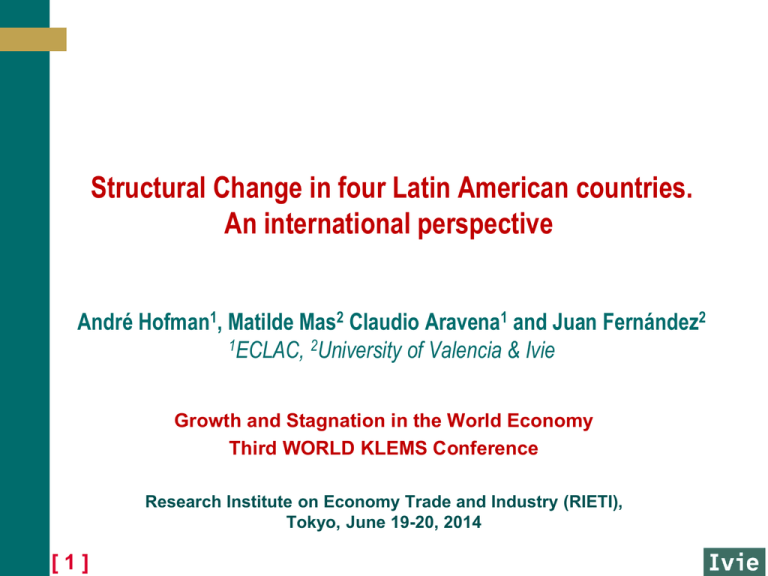
Structural Change in four Latin American countries. An international perspective André Hofman1, Matilde Mas2 Claudio Aravena1 and Juan Fernández2 1ECLAC, 2University of Valencia & Ivie Growth and Stagnation in the World Economy Third WORLD KLEMS Conference Research Institute on Economy Trade and Industry (RIETI), Tokyo, June 19-20, 2014 [1] Introduction Structural change has received great attention, specially in Latin America. A central insight in development economics is that development entails structural change. The main argument of the so called structuralist school is that the economic structure is very relevant, so that structural change is the clue for explaining growth & convergence from a Schumpeterian perspective (CEPAL 2000, 2012; BID 2010) One of the best documented patterns of structural change is the shift of labor and capital from production of primary goods to manufacturing and later to services. This featured prominently in explanations of divergent growth patterns across Europe, Japan, and the US in the post WWII period (Denison, Maddison, Jorgenson, Timmer) In Latin America the relevant literature goes back to the works of Raúl Prebish and Fernando Fajnzylber whose ideas have been analyzed from many different perspectives. [2] Introduction More recently an important number of Latin American, as well as non LA authors, have focused on the role played by structural change in LA productivity growth. Among LA authors need to be mentioned (without aim of exhaustivity) J. Weller, M. Cimolli, C. Pagés, D. Restuccia, and M. Duarte just to mention a few of them. And regarding the non-LA authors, D. Rodrik, M. McMillan, M. Timmer & G. de Vries among others. Recent literature has focused on productivity determinants by using micro data. The results highlight the relevance of the structural change even for developed economies (Bartelsman & Dooms, 2000; Syverson, 2011). In what follows we will take the McMillan & Rodrik (2012) article as reference. Our results are very close to the ones obtained by D. Restuccia (2012) following a somehow different avenue. [3] McMillan & Rodrik (2012) Countries: 38 9 High Income; 10 Asia; 1 Middle East (Turkey); 9 Africa and 9 LA (Argentina, Chile, Mexico, Venezuela, Costa Rica, Colombia, Peru, Brazil & Bolivia) Variable analyzed: Labor Productivity Sectoral Dissagregation: 9 sectors Period: 1990-2005 Source: GGDC 10-Sector Database Methodology: Shift-Share Analysis [4] McMillan & Rodrik (2011) Main findings The bulk of the difference between Asia & LA countries productivity performance is accounted for by differences in the pattern of structural change –with labor moving from low to high productivity sectors in Asia, but in the opposite direction in LA & Africa. In countries with a relative large share of natural resources in exports, structural change has typically been growth reducing. Reason: those sectors have very high productivity but they cannot absorb the surplus of labor from agriculture. Developing countries are characterized by large productivity gaps between different parts of the economy. They are indicative of the allocative inefficiencies that reduce overall labor productivity. The upside of these allocative inefficiencies is that they can potentially be an important engine of growth. When labor & other resources move from less to more productive activities, the economy grows even if there is no productivity growth within sectors. Main result: Countries that do well are those that start out with a lot of workers in agriculture but do not have a strong comparative advantage in primary products. [5] This paper´s contribution Takes as reference 4 LA countries (Argentina, Brazil, Chile & Mexico); and 7 more countries to which we will refer from now on as reference countries: 5 EU countries (France, Germany, UK, Italy & Spain); USA & Japan, for period 19952008/2009 and 9 sectors. Major drawback: Asian countries are not included (yet) in the exercise for lack of comparable data. Presents Growth Accounting results, decomposing labor productivity growth in the contribution of 4 sources of growth (ICT and non-ICT capital; labor qualification; and TFP). Shows a set of descriptive statistics in order to help understand what happens inside each country Applies shift-share analysis to each individual variable: Labor productivity; capital per worker ICT and non-ICT capital; Total Factor Productivity Analyzes the sensitivity of the results to the level of industry disaggregation taking Mexico and the reference countries as illustration. [6] Growth Accounting Results Labor productivity. 1995-2007 (percentage) Contributions (percentage points) to labor productivity growth Labor productivity growth rate France Germany Italy Spain UK EU-15ex¹ US Japan² Argentina Brazil Chile Mexico 1.53 1.55 0.51 0.67 2.06 1.39 2.02 2.10 1.68 0.63 2.56 1.21 Changes in labor composition Total capital per hour worked ICT capital per hour worked Non-ICT capital per hour worked TFP Realloc ation effect 0.31 0.05 0.09 0.38 0.48 0.19 0.26 0.39 0.37 0.94 0.80 0.39 0.64 0.75 0.61 0.93 1.04 0.80 1.15 1.20 0.61 0.24 2.04 0.69 0.27 0.39 0.22 0.36 0.66 0.42 0.76 0.34 0.40 0.55 0.32 0.38 0.37 0.36 0.39 0.56 0.39 0.38 0.39 0.86 0.21 -0.31 1.71 0.31 0.49 0.59 -0.34 -0.63 0.63 0.40 0.72 0.28 0.44 -1.17 -0.55 -0.22 0.08 0.15 0.15 -0.02 -0.09 0.01 -0.11 0.23 0.27 0.62 0.28 0.34 ¹ EU-15ex is formed by Germany, Austria, Belgium, Denmark, Spain, Finland, France, Italy, Netherlands and UK. ² 1995-2006 Source: EU KLEMS (2011), LA KLEMS (2013) and own elaboration [7] Growth Accounting Results Labor productivity. 1995-2007 (percentage) 5 4 3 2 1 0 -1 -2 France Germany Italy Spain United Kingdom EU-15ex¹ US Japan² Argentina Brazil Chile Labour composition ICT Capital per hour Non-ICT Capital per hour TFP Reallocation effect Labour productivity ¹ EU-15ex consist of Austria, Belgium, Denmark, Finland, France, Germany, Italy, Netherlands, Spain and United Kingdom ² 1995-2006 period for Japan Source: EU KLEMS (2011), LA KLEMS (2013) and own elaboration. [8] Mexico Growth Accounting Results Comparison of LA with reference countries (period 1995-2007): • Great array of labour productivity growth rates among both, reference and LA countries. • The contributions of changes in labor composition (human capital) was higher in LA countries (as expected due to the LA relative laggard position). • The contribution of K/L was more heterogeneous in LA than in reference countries: rather modest in Brazil, Argentina and Mexico and very high in Chile. • The contribution of ICT K/L was in line with the EU average while the contribution of non ICT K/L was also more heterogeneous in LA than in reference countries. It was very high in Chile but negative in Brazil. • TFP contribution was negative in 3 out of 4 LA countries (the exception is Argentina). [9] Growth Accounting Results • Generally speaking, negative TFP contribution was the main cause for low productivity growth. If TFP growth would have been zero (instead of negative) Labour Productivity growth would have been almost three times higher in Brazil; 21.5% higher in Chile, and 18.2% higher in Mexico. • It is also important to notice that the “Reallocation effect” –which is a measure of structural change- was positive in LA countries and higher than in reference countries. In UK, US and Spain it was even negative. [ 10 ] Descriptive Statistics Labor Productivity K/L ratio Non ICT K/L ratio ICT K/L ratio TFP (US 1995=100) [ 11 ] Descriptive Statistics. Labor Productivity ($ PPP 1995) France º 1995 2007 25.59 30.83 1995 2007 0.49 0.58 2007 6.49 Sector Labor productivity E 124.05 Sector Labor productivity AtB 19.12 1995-2007 [ 12 ] 1.53 Germany Italy Spain United Kingdom United States Japan Argentina Economy-wide Labor productivity 23.95 22.76 20.71 25.80 19.88 25.44 24.45 26.74 33.32 25.66 Standard deviation of log of sectoral labor productivity 0,50 0.65 0.56 0.84 0.59 0.73 0.54 0.68 0.71 0.79 0.69 0.86 Max-min ratio 6.46 7.88 10.56 9.40 12.01 20.58 Sector with Highest Labor productivity in 2007 E E E C E E 102.09 118.26 176.83 151.12 163.52 190.95 Sector with Lowest Labor productivity in 2007 AtB AtB F F F AtB 15.81 15.00 16.74 16.08 13.61 9.28 Compound Annual Growth rate of Econ. Wide Labor productivity 1.55 0.51 0.67 2.06 2.02 2.10 25.76 31.03 Brazil Chile Mexico 10.97 13.51 6.27 6.74 7.79 10.92 10.02 11.70 0.81 0.61 0.91 0.86 0.91 0.85 0.94 0.94 5.53 14.68 12.87 14.19 E 51.05 E 42.26 C 72.93 C 46.17 GtH 9.24 AtB 2.88 AtB 5.66 AtB 3.25 1.68 0,63 2,56 1.21 TOTAL ECONOMY TOT Agriculture and fishing Mining and quarrying Manufacturing Electricity, gas and water supply Construction Wholesale and retail trade; hotels and restaurants Transport and communications Finance, insurance, real estate and business services Community social and personal services AtB C D E F GtH I JtK LtQ Labor Productivity • Labor productivity in LA countries is around 1/3 of the reference countries. Specially low in Brasil, while Argentina and Mexico present the highest levels. • In the majority of countries the sector with the highest level of labor productivity is Electricity, gas & water supply. The exceptions are UK, Chile & Mexico for which it is Mining & Quarrying. • In most countries the sector with the lowest level of labor productivity is Agriculture and Fishing. In Argentina it is Wholesale and retail trade; hotels & restaurants, while in Spain, UK, and USA it is Construction. • The dispersion of sectoral labor productivities –as measured by the standard deviation of logs- is higher in 3 LA countries than in the EU average. • The same result holds when using the ratio max/min as dispersion indicator (except for Argentina). • These results are in line with those highlighted in the literature. [ 13 ] Descriptive Statistics: K/L ratio ($ PPP 1995) France 1995 2007 52.88 62,18 1995 2007 1.03 1.03 2007 41.28 Sector Capital / Labor ratio E 568.82 Sector Capital / Labor ratio F 13.78 1995-2007 2.49 Germany Italy Spain United Kingdom United States Japan Argentina Economy-wide Capital / Labor ratio 99.21 45.92 31.55 40.87 46.04 113.47 57.39 45.99 60.02 65.37 Standard deviation of log of Capital / Labor ratio 1.02 1.24 1.02 1.60 1.45 1.30 1.11 1.15 1.15 1.49 1.37 1.39 Max-min ratio 50.52 32.89 40.43 135.94 74.06 164.66 Sector with Highest Capital / Labor ratio in 2007 E E E C E E 582.90 911.76 785.04 1113.84 888.16 1633.41 Sector with Lowest Capital / Labor ratio in 2007 F F F F F F 11.54 27.72 19.42 8.19 11.99 9.92 Compound Annual Growth rate of Econ. Wide Capital / Labor ratio 3.48 2.33 2.56 3.97 3.71 3.45 50.30 66.28 Brazil Chile 15.86 17.99 9.23 10.58 10.80 21.83 20.03 23.81 0.55 0,76 1.17 1.27 1.40 1.55 1.73 1.56 11.42 34.18 155.70 126.35 C 27.64 E 84.81 E 375.28 E 645.86 F 2.42 GtH 2.48 F 2.41 AtB 5.11 1.82 0.79 6.05 1.64 Japan: 2007 not available, data correspond to 2006. [ 14 ] Mexico TOTAL ECONOMY TOT Agriculture and fishing Mining and quarrying Manufacturing Electricity, gas and water supply Construction Wholesale and retail trade; hotels and restaurants Transport and communications Finance, insurance, real estate and business services Community social and personal services AtB C D E F GtH I JtK LtQ Descriptive Statistics: Non-ICT K/L ($ PPP 1995) France 1995 2007 50.88 57.50 47.93 57.65 1995 2007 1.04 1.05 1.04 1.16 2007 43.27 54.15 E E 540.25 559.55 F F Sector non-ICT Capital / Labor ratio Sector non-ICT Capital / Labor ratio 1995-2007 Germany 12.49 1.63 Italy United Kingdom United States Japan Economy-wide Non-ICT Capital / Labor ratio 96.91 43.65 29.46 37.78 43.93 106,87 50.82 34.99 45.66 60.18 Standard deviation of log of non-ICT Capital / Labor ratio 1.25 1.03 1.63 1.48 1.31 1.17 1.19 1.59 1.50 1.42 Max-min ratio 35.35 41.95 159.22 98.08 171.86 Sector with Highest non-ICT Capital / Labor ratio in 2007 E E C E E Argentina Brazil Chile Mexico 15.22 15.51 7.96 7.30 10.72 19.94 19.39 21.13 0.54 0.77 1.24 1.30 1.41 1.62 1.74 1.65 12.50 43.57 208.09 124.09 C E E E 26.97 60.29 367.47 618.58 F JtK F AtB 10.33 25.47 18.01 6.97 8.42 9.31 2.16 Compound Annual Growth rate of Econ. Wide non-ICT Capital / Labor ratio 2.09 1.64 1.61 1.44 1.26 2.74 1.08 1.38 1.77 4.99 -1.03 5.23 0.79 900.28 755.59 1109.78 825.58 1600.01 Sector with Lowest non-ICT Capital / Labor ratio in 2007 F F F F F Japan: 2007 not available, data correspond to 2006 [ 15 ] Spain TOTAL ECONOMY TOT Agriculture and fishing Mining and quarrying Manufacturing Electricity, gas and water supply Construction Wholesale and retail trade; hotels and restaurants Transport and communications Finance, insurance, real estate and business services Community social and personal services AtB C D E F GtH I JtK LtQ Descriptive Statistics: ICT K/L ($ PPP 1995) France Germany 1995 2007 2.00 4.68 2.37 8.63 1995 2007 1.74 1.51 1.14 1.18 2007 164.81 24.92 E JtK 28.57 23.96 AtB AtB Sector ICT Capital / Labor ratio Sector ICT Capital / Labor ratio 0.17 1995-2007 7.72 Italy United Kingdom United States Japan Economy-wide ICT Capital / Labor ratio 2.30 2.27 2.09 3.08 2.11 6.60 6.57 11.00 14.36 5.19 Standard deviation of log of ICT Capital / Labor ratio 1.76 2.00 1.65 1.36 1.48 1.25 1.68 1.66 1.21 1.64 Max-min ratio 82.45 219.45 208.15 30.32 159.05 Sector with Highest ICT Capital / Labor ratio in 2007 I E E E E Argentina Brazil Chile Mexico 0.64 2.48 1.26 3.28 0.07 1.89 0.64 2.67 2.44 1,98 1.17 1.39 1.04 1.08 1.92 1.46 439.71 54.34 32.88 215.18 LtQ C E E 3.40 44.23 7.81 27.27 AtB AtB AtB AtB 0.96 0.30 0.13 0.28 2.06 0.21 0.01 Compound Annual Growth rate of Econ. Wide ICT Capital / Labor ratio 10.75 8.80 8.85 13.86 12.82 8.18 8.90 0.81 0.24 0.13 7.96 27.23 11.92 25.07 29.45 58.12 62.58 33.40 Sector with Lowest ICT Capital / Labor ratio in 2007 AtB AtB AtB AtB AtB Japan: 2007 not available, data correspond to 2006. [ 16 ] Spain TOTAL ECONOMY TOT Agriculture and fishing Mining and quarrying Manufacturing Electricity, gas and water supply Construction Wholesale and retail trade; hotels and restaurants Transport and communications Finance, insurance, real estate and business services Community social and personal services AtB C D E F GtH I JtK LtQ K/L, ICT K/L and Non-ICT K/L ratios The level of capitalization –as measured by the three ratios- is lower in LA than in the other countries. The sector with the highest K/L and Non-ICT K/L ratio is, in almost all countries, Electricity, gas & water supply. In UK and Argentina it is Mining & quarrying. These results confirm that, generally speaking, the highest the K/L ratio, the highest is labor productivity. The sector with the lowest level of K/L and Non-ICT K/L ratio is Construction. In Brazil it is Wholesale &retail trade; hotels & restaurants for K/L and Finance, insurance, real state & business services for Non-ICT. In Mexico, Agriculture & fishing. For ICT K/L the lowest level corresponds, in all countries, to Agriculture & fishing. The dispersion of the K/L and Non-ICT K/L ratio is (only slightly) higher in LA (with the exception of Argentina) than in EU countries. For ICT K/L ratio the dispersion in LA countries is not different from the other countries (high variability of the dispersion indicators among all countries) [ 17 ] Descriptive Statistics: TFP (US 1995=100) • Levels of TFP have been calculated following Hulten & Schwab (1993) using a reference to obtain a transitive indicator which is comparable across sectors, countries and years. • The reference used is Total US economy in the initial year (1995). • TFP is calculated according to the following expression: lnTFPitk lnYitk lnY0 j 1 s jitk s j 0 ln X jitk ln X j 0 2 Where: • i sector; t year; k country • Subscripts 0 refer to the values of each variable in the Total US economy in 1995. • Y: value added • s: factor share • Xj: production factors (Labor quantity and quality, KICT and KNICT) • TFP is calculated as the exp(lnTFP)*100 and takes the value 100 for the reference country (US). • Hulten, C.R., R. Schwab (1993): “Endogenous growth, public capital, and the convergence of regional manufacturing industries”, NBER Working Paper 4538. [ 18 ] Descriptive Statistics: TFP (US 1995=100) France Germany 1995 2007 94.37 99.61 95.92 100.84 1995 2007 0.24 0.26 0.34 0.19 2007 2.36 2.04 Sector TFP E 153.36 D 142.54 Sector TFP AtB 64.86 AtB 69.96 0.45 0.42 1995-2007 Italy Spain United Kingdom United States Japan Argentina Economy-wide TFP 86.26 86.31 100.00 75.39 79.50 92.82 109.72 77.99 Standard deviation of log of TFP 0.30 0.18 0.25 0.24 0.40 0.25 0.26 0.25 0.43 0.42 Max-min ratio 2.61 2.00 2.00 4.42 4.61 Sector with Highest TFP in 2007 C E D D C 133.56 140.15 133.98 180.06 126.57 Sector with Lowest TFP in 2007 AtB LtQ LtQ C AtB 51.22 70.19 66.85 40.72 27.47 Compound Annual Growth rate of Econ. Wide TFP -0.47 -0.68 0.61 0.77 0.31 75.59 71.42 Brazil Chile 61.53 66.69 37.41 33.00 46.03 43.55 49.57 47.01 0.84 0.65 0.65 0.58 0.57 0.51 0.71 0.66 8.86 5.48 5.99 9.66 E 367.31 Jtk 107.63 C 134.63 JtK 186.52 LtQ 41.46 GtH 19.63 LtQ 22.48 E 19.30 0.67 -1.04 -0.46 -0.44 Japan: 2007 not available, data correspond to 2006 [ 19 ] Mexico TOTAL ECONOMY TOT Agriculture and fishing Mining and quarrying Manufacturing Electricity, gas and water supply Construction Wholesale and retail trade; hotels and restaurants Transport and communications Finance, insurance, real estate and business services Community social and personal services AtB C D E F GtH I JtK LtQ TFP The level of TFP is lower in LA countries (around half that of the reference countries). There is not a common sectoral pattern among countries. The highest TFP corresponds to Electricity, gas & water supply (France, Spain & Argentina); Manufacturing (Germany, UK, US); Mining & quarrying (Italy, Japan & Chile); or Finance & insurance (Brazil & Mexico). The lowest TFP corresponds to Agriculture & fishing (France, Germany, Italy & Japan); Community, social & personal services (Spain, UK, Argentina & Chile); and Wholesale & retail trade, hotels & restaurants (Brazil). The dispersion –as measured by the standard deviation of logs- is clearly higher in LA countries (around twice that of the reference countries). The same is true for the max/min ratio (more than double in LA countries than in the reference countries). In fact, this is the variable for which the dispersion is clearly highest in LA countries. This means that the differences in the levels of efficiency achieved by the different sectors in LA countries is very high. In fact, most of the dispersion found in Labor Productivity can be attributed to TFP. [ 20 ] Shift-Share Analysis Labor Productivity K/L ratio Non ICT K/L ratio ICT K/L ratio TFP [ 21 ] Shift-shares • Labor productivity shift-share has been calculated according to the following precise expression: VA VA VA VA VA VAt VA0 q j 0 jt j 0 q jt q j 0 j 0 q jt q j 0 jt j 0 L L Lt L0 L j 0 j Lj0 L j 0 j j jt jt Within component Structural change component Dynamic component • Where qjt is the weight of employment of sector j in total employment in year t. The subscript 0 refers to the initial year, 1995. • However, the last term of the expression is of no direct interpretation. Thus in the following slides, only the within component and structural change components are shown. • Additionally, to make the decomposition exact after dropping the dynamic component, the total variation of labor productivity is broken down in the within and structural change component according to the weight of each components in the sum of these two. • In the rest of the shift-shares the procedure has been analogous. • When changes in employment share are positively correlated with productivity levels, the “structural change” term will be positive meaning that the structural change increases economy wide productivity growth. [ 22 ] Shift-share decomposition. 1995-2007 Labor productivity growth rate Total StructuWithin ral change Capital / labor ratio Total StructuWithin ral change ICT capital / labor ratio Total StructuWithin ral change Non-ICT capital / labor ratio TFP Total StructuWithin ral change Total StructuWithin ral change France 1.53 1.46 0.06 2.49 2.78 -0.29 7.72 7.60 0.13 1.63 1.892 -0.267 0.45 0.45 0.00 Germany 1.55 1.37 0.18 3.48 3.36 0.13 11.03 10.67 0.36 2.09 2.016 0.079 0.42 0.40 0.02 Italy 0.51 0.36 0.16 2.33 0.21 2.12 8.03 7.73 0.29 1.64 -0.171 1.815 -0.47 -0.64 0.17 Spain 0.67 0.69 -0.02 2.56 3.06 -0.51 8.77 8.79 -0.02 1.61 2.088 -0.478 -0.68 -0.72 0.04 UK 2.06 2.22 -0.16 3.97 4.45 -0.48 12.51 12.42 0.09 1.44 1.856 -0.417 0.61 0.79 -0.19 US 2.02 2.10 -0.08 3.71 4.10 -0.39 12.46 12.49 -0.03 1.26 1.559 -0.296 0.77 0.82 -0.05 Japan² 2.10 1.89 0.20 3.45 3.39 0.06 8.03 7.34 0.69 2.74 2.727 0.017 0.31 0.41 -0.10 Argentina 1.68 1.22 0.46 1.82 1.93 -0.11 8.90 8.60 0.30 1.08 1.637 -0.556 0.67 0.35 0.32 Brazil 0.63 0.10 0.53 0.79 0.53 0.26 7.56 7.04 0.52 -1.03 -1.918 0.886 -1.04 -1.28 0.24 Chile 2.56 2.34 0.23 6.05 6.23 -0.18 26.79 26.75 0.04 5.23 5.417 -0.183 -0.46 -0.41 -0.06 Mexico 1.21 0.88 0.33 1.64 1.64 0.00 13.13 12.82 0.32 0.79 0.806 -0.020 -0.44 -0.30 -0.14 [ 23 ] Shift Share Analysis: Main Results • The main contributor to growth for all countries –both, LA and reference- and all variables is the within effect. • The structural change component for labor productivity has a positive & also a higher contribution in all LA countries than in the reference ones. Brazil and Argentina present the highest values. • For the K/L ratio, as well as for the ICT K/L and non ICT K/L ratio, the structural change component is only relevant for Brazil but not for the rest of LA countries. Thus, the within component is the main determinant of K/L growth. • The within component for TFP is negative in 3 LA countries, specially in Brazil (Argentina is the exception). Thus, the main responsibility for the negative contribution of TFP must be found inside the individual sectors. • However, the structural change component for the TFP variable is positive in Brazil and Argentina, indicating the existence of positive spillover effects among sectors in these two countries. For Mexico and Chile the structural change effect is negative though negligible in the second. [ 24 ] Importance of the level of disaggregation • Is the relevance of the structural change contribution dependent upon the level of available industry disaggregation? • Labor productivity is available for 65 industries in the case of Mexico and for 31 industries in the case of the reference countries. In both cases for period 1995-2007. • For the reference countries the level of disaggregation does not really affect the shiftshare results. The exceptions are Spain & Italy. For the former, the 31 industries disaggregation generates a higher, and positive, structural change component. For Italy it happens the opposite. • For Mexico, the structural change component increases continuously with the level of industry disaggregation. For the 9 industries disaggregation it represents 27.5% of total LP variation, while for the 65 industries it goes up to 45.8%. France Germany 31 inds 9 inds Total variation Within Structural change [ 25 ] 100.0 Italy Spain 31 inds 9 inds 31 inds 9 inds 31 inds 9 inds 100 100.0 100 97.7 95.77 82.8 88.13 101.7 69.52 17.2 11.87 -1.7 30.48 2.3 4.23 UK 100.0 100 100.0 100 49.7 103.16 50.3 -3.16 US 31 inds 9 inds 100.0 100 103.4 107.78 -3.4 -7.78 Japan² Mexico 31 inds 9 inds 31 inds 9 inds 65 inds 31 inds 9 inds 100.0 100 100.0 100 100 100.0 100 103.1 104.07 97.6 90.41 54.18 67.6 72.51 2.4 9.59 45.82 32.4 27.49 -3.1 -4.07 Summarizing The within effect is the most relevant for all variables and countries growth. The results seem to indicate that LA countries have benefited from positive, through small, structural change in comparison with the reference countries. Only after comparing with Asian countries included in the WORLD KLEMS project we will be able to conclude if structural change has been less important in LA as McMillan & Rodrik conclude. The results for Mexico indicate that the structural change analysis should widen the scope moving from traditional Agriculture / Manufacturing / Services sequence, to a more detailed sectoral analysis. What is relevant, at least for that country, is to which manufacturing or service sectors is labor moving (not the general move). The relatively low productivity growth in LA had its origin in the (negative) TFP contribution in 3 out of 4 LA countries (Argentina is the exception). This negative TFP contribution must be blamed on the within component in the 3 countries, and not on the structural change component which was positive in Argentina & Brazil, (slightly) negative in Chile and Mexico. [ 26 ] Summarizing Taken all together the results indicate that LA countries need improving the efficiency of their production process through measures that go beyond standard tangible capital accumulation. They need to take measures oriented to accomplish improvements within the sectors. These measures include enhancing the functioning of the labor markets, increasing R&D, improving human capital both at the school but especially at the workplace, and most of the intangibles assets which help to obtained more efficient results from the same quantity of capital and labor. They also need to intensify the structural change but taking into account that a mere movement form Agriculture to Manufacturing and Services is not enough. Both Manufacturing and Services aggregates are very heterogeneous, so the focus should move to the most productive industries within these two big aggregates. [ 27 ] Structural Change in four Latin American countries. An international perspective André Hofman1, Matilde Mas2,Claudio Aravena1 and Juan Fernández2 1ECLAC, 2University of Valencia & Ivie Growth and Stagnation in the World Economy Third WORLD KLEMS Conference Research Institute on Economy Trade and Industry (RIETI), Tokyo, June 19-20, 2014 [ 28 ]
